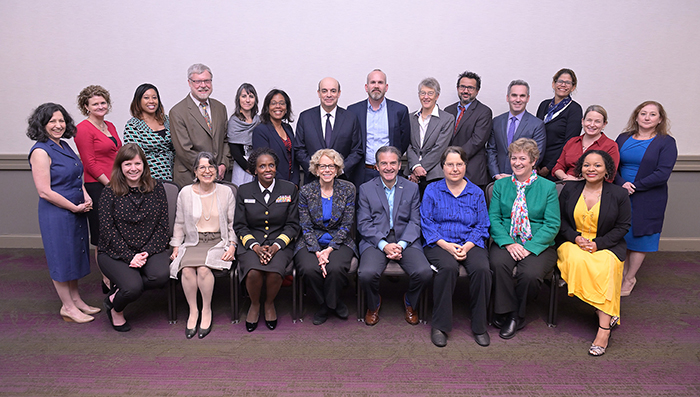
“Pregnancy is a rollercoaster ride,” said Mavis Stephens, a U.S. Army veteran and longtime federal patient coordinator as she addressed a group of researchers and healthcare advocates at a recent NICHD forum on maternal mortality and women’s health. “When you get on a rollercoaster, there are signs that say, ‘you need to be this tall to ride. If you’re not, don’t ride,” added Stephens. “We need those signs for pregnancy.”
Stephens spoke at the Community Engagement Forum on Improving Maternal Health in early April 2019. The forum was the first of a series of NICHD meetings focused on maternal mortality, a key research priority for the institute. NICHD Director Diana W. Bianchi, M.D., began the meeting by reiterating the institute’s longstanding commitment to maternal health research; NICHD funding, which accounts for about 60 percent of total NIH spending in this area, supports 10 research programs and clinical trials networks that address maternal health issues.
A second meeting in May identified research gaps in data collection, clinical obstetrical factors, and health disparities, specifically racial and ethnic inequalities, in the care of women before, during, and after pregnancy.
“The bottom line is if you are black in this country, you are three to four times more likely to die from pregnancy-related death, compared to your white counterpart,” said workshop keynote speaker Elizabeth Howell, M.D., M.P.P., an NICHD grantee from the Icahn School of Medicine at Mount Sinai Hospital, who shared findings from her research defining and measuring pregnancy outcome disparities in New York City.
A May 7 report from the Centers for Disease Control and Prevention (CDC) confirmed persistent racial inequities in maternal deaths in the United States. In addition, serious and life-threatening complications following pregnancy, called severe maternal morbidity, have been steadily increasing. CDC estimates that since 2014, more than 50,000 U.S. women have been affected by severe, unexpected complications from labor and delivery.
Listening to Pregnant Women
In the April NICHD meeting, Stephens put a personal face on those statistics, recounting her traumatic pregnancy experience with preeclampsia, a complication marked by a sudden increase in blood pressure. Her near-death experience more than 20 years ago motivated her to become a volunteer speaker for the Preeclampsia Foundation. At age 25 and 5 months pregnant, she began experiencing intense headaches and blurred vision, signs that her doctors didn’t take seriously. According to Stephens, at her 27th week checkup, her doctor took her blood pressure and immediately sent her to the emergency room. Within a week, she had an emergency C-section, but sadly her baby boy died two days later.
“My genetics were not my friend,” said Stephens. “Clinicians, providers need to look at these signs.”
Her mother had high blood pressure, a heart attack before the age of 50, and a stroke in her early 60s. “Family history matters,” said Stephens. Two years later, she was pregnant again, but this time she was monitored closely by her doctors. She was able to deliver a baby boy, who recently celebrated his 22nd birthday.
Stephen’s call to listen more to pregnant women was echoed by several speakers who emphasized the need to document personal experiences.
Looking Forward
The goal of the two NICHD workshops was to inform a future research agenda, one that will have the highest impact on reducing maternal mortality and severe morbidity.
“Certainly, there are hurdles to overcome,” said Charisee Lamar, Ph.D., director of NICHD’s Office of Health Equity, in her closing remarks at the May workshop. “We must address data inconsistences in the study of maternal health—including how and when it is collected. We must also examine and address social, environmental, and structural factors that contribute to morbidity and mortality.”

 BACK TO TOP
BACK TO TOP